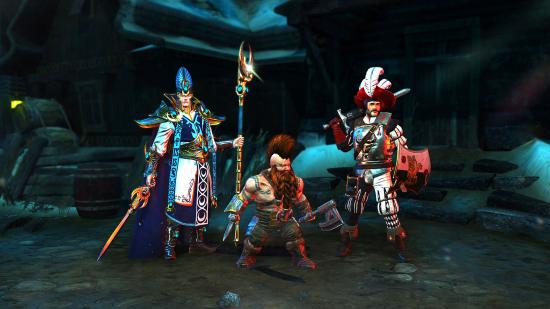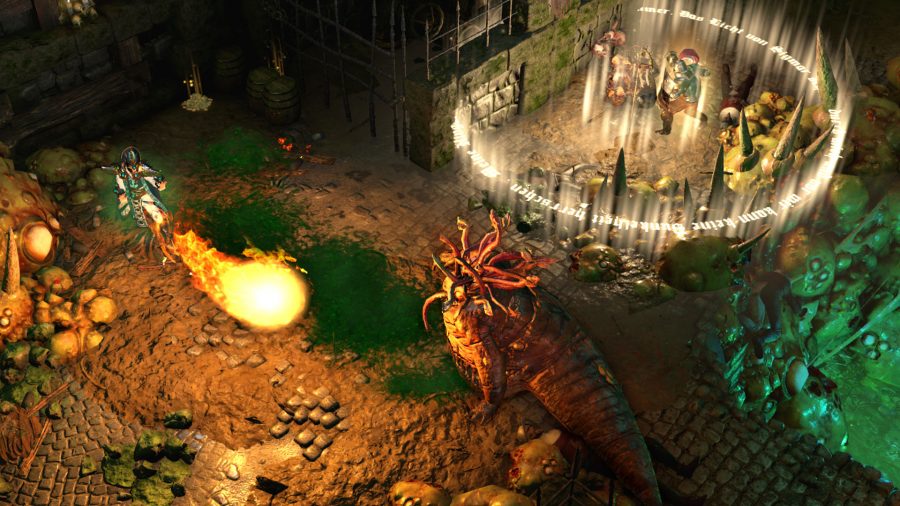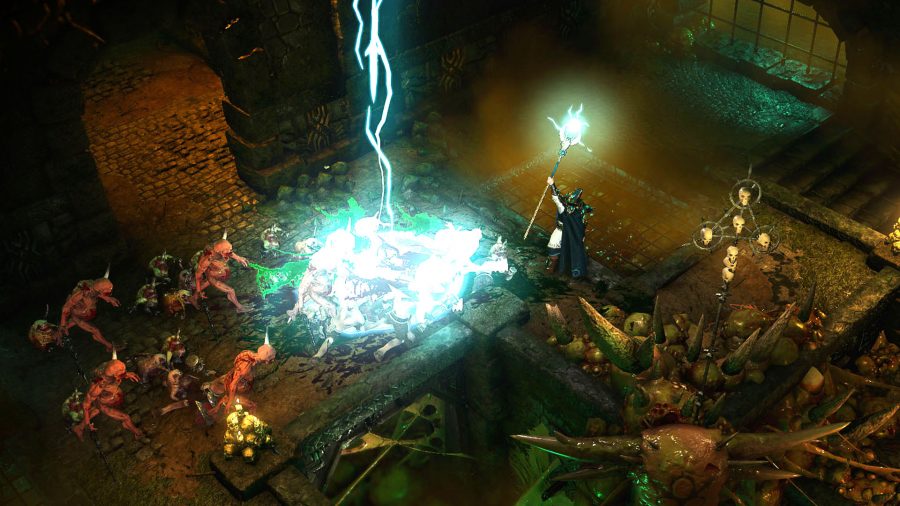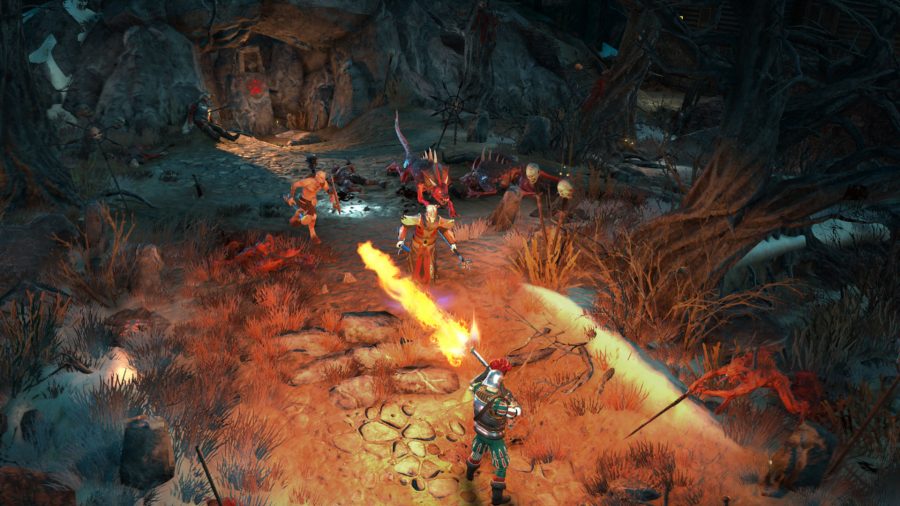When Warhammer: Chaosbane was first announced, it was with a meagre two screenshots and a whole lot of promises. Given the previous form of Warhammer games, the reaction I recall was one of scepticism, and even a little weariness: ‘Oh great, another Warhammer game made by a small studio. How crap is this going to be?’
Don’t discount it. Vermintide was once a Warhammer game made by a small studio, after all, and Chaosbane developer Eko Software has experience in the action-RPG genre, having made How to Survive 2. I was pleasantly surprised when I got to play the studio’s foray into Games Workshop at Gamescom, and again when the devs swung by to show off the fiery Dwarf Slayer.
A Slayer was chosen because, as game director Jean-Georges Levieux explains, they are the most iconic flavour of dwarf in Warhammer Fantasy. The badass orange-dyed mohawks you see them sporting are a mark of shame for breaking a promise – a sin so severe, to a Warhammer dwarf, that it borders on the metaphysical. What’s a little less badass, at least from their perspective, is the permanent exile – and the custom that an oathbreaker can only regain their honour if they die in battle while trying to kill the biggest thing they can find. Some Slayers are so unsuccessful that they become Dragonslayers and even Daemonslayers before they’re finally killed – embarrassing amateurs, when it comes to dying. So desperate are they to shuffle off their hairy coil that the only protection they’ll allow themselves are tattoos.
They’re not the heavily-armoured stoics of every other RPG, then. Chaosbane leaves the tanking to the Empire Soldier, allowing the Slayer to become your melee DPS. And as I discover, he’s a hell of a lot of fun.

Slayers traditionally carry several axes, two of which are attached to their forearms by chains. I suppose it’s like having a favourite pen – it doesn’t matter how many others you’ve got, you don’t want to lose that one. And in Chaosbane, every character has a defining ability mapped to the right stick (holding the spacebar will activate the same function with a mouse).
Read more: Venture forth into the best RPGs on PC
Nudging it throws one of the Slayer’s chained axes in the appropriate direction, before pulling him along with it a moment later. If the axe connects with an enemy, you’ll get a small burst of energy, so you can use one of your stronger attacks right away. It’s a terrific way to initiate fights, but also far more versatile than that. It can get you out of the melee and into the enemy backline so you can kill their support characters, and it’s why you’re the best equipped to catch baddies when they flee. It’s also a potential escape – though using it as such isn’t very Slayer-like.It’s all immensely satisfying. The axe buries itself in the terrain with a chunky plink, and the sudden leap that follows is exhilarating when your move speed is otherwise one-gear.
Elsewhere in the hero roster, the High Elf uses the right stick to direct his spells, while the Empire Soldier throws out his shield in a move that interrupts enemy attacks. This has been revised since the Gamescom build, in which he simply held his shield up to tank damage. After further testing it was deemed to be too passive, and having played both, the replacement feels much better. It’s a thoughtful change, and an encouraging sign of Eko’s attention to detail.
As the Slayer, my other abilities include a spinning axe attack that slowly drains energy as its button is held, a heavy slashing attack with a broad reach, and a short-range bubble that heals myself and allies within range. Drawing on the powers of the vengeful Dwarfen Ancestor god Grimnir, I also have two superpowers on the shoulder buttons – an alternative initiation attack that jumps further and hits harder than the chains, and a deadly AoE that melts the ground with lava. The Slayer roars and shouts upon the use of almost every one of these. It’s all appropriately angry.
But Levieux pops open the menu, and I realise that this setup is only one of hundreds of potential builds. You can choose freely from dozens of different god powers, as well as active and passive skills. There’s also a crafting system in which options can be linked to generate emergent effects, multiplying your options rather than simply adding to them. This implies huge depth in build creation – so much, indeed, that I wonder if it’s possible to retain each character’s distinctive role. It sounds as if team synergies will be more important on higher difficulties or in endgame content – one example given is a competitive boss challenge, where you’ll compete with other players to post the quickest kills – whereas at lower stakes you can get away with more experimentation.
Chaosbane’s apparent quality signals a larger change in Warhammer. I’m told that Games Workshop is aware of how its licensed games are generally seen, and is looking to raise the quality bar. Combined with the fact that it destroyed Warhammer Fantasy and replaced it with Age of Sigmar, this has meant that Eko had to work doubly hard to get the nod to make a game based in what’s now simply called the World-That-Was.
But Eko won Games Workshop round. The team really loves this world, as I discover when Levieux and I discuss our Dwarf armies. Chaosbane is set in the aftermath of the Great War against Chaos – a little over 200 years before the Warhammer world’s apocalypse – when the forces of Chaos are waxing again after Magnus the Pious beat them back. We’re promised a proper story with twists, turns, and betrayals, written by Mike Lee of Games Workshop’s very own publishing label, Black Library. I’m told that major characters from the period will make an appearance – including Teclis, the High Elf Archmage who taught humanity to wield magic – but it’s not clear how prominently they’ll feature. Each of the four core characters is a character, with a backstory introduced in a cutscene, and a personality that’ll emerge through in-mission dialogue. As a fan of the setting, this is very exciting, but none of it is in the build I play. Eko is still recording the dialogue.
The story is divided into four acts, each linked to a different Chaos God. So far we’ve seen Nurgle in Nuln, and today I chop up Khorne’s acolytes in Praag (not to be mistaken for Prague – for that you’ll want Deus Ex). I ask if we’ll get to see Bloodcrushers and Bloodthirsters, and am told ‘yes’ to the first and, coyly, “we have Greater Daemons” to the second. But today I must make do with Bloodletters. Close enough.
Related: What’s been going on with Diablo 4?
We’ve had a hint of Praag in those early screenshots, but this is the first time it’s been playable, and the snowbound streets are a nice change from the grim and greasy sewers of Nuln. As a northern city, though, Praag is close to Chaos, and bony spikes jut from the ground. There’s corruption here, and it’s going to kick off. The perfect place for a dwarf looking for a heroic death.



